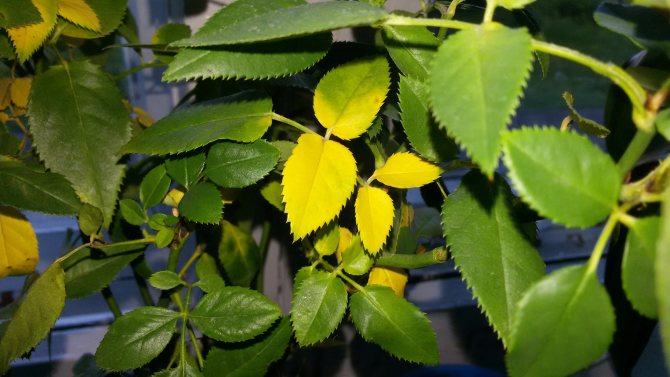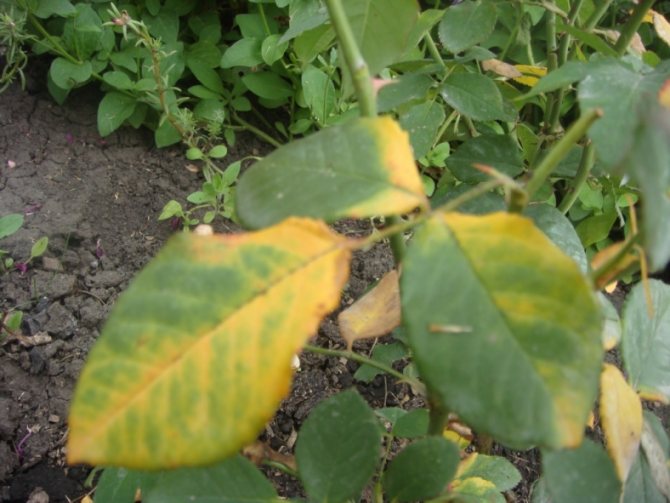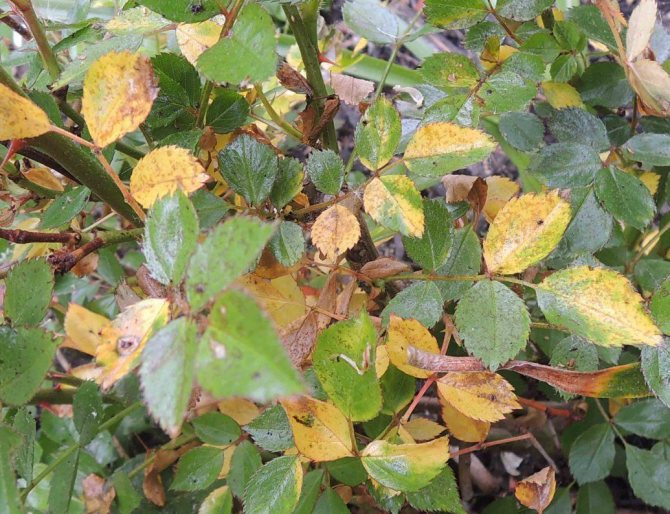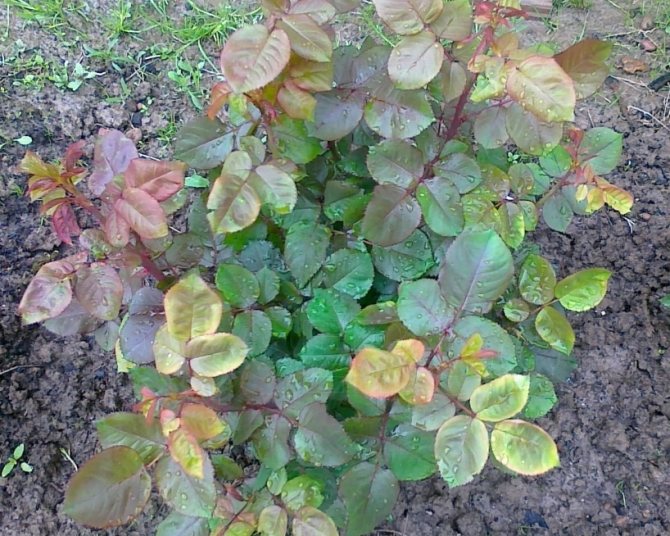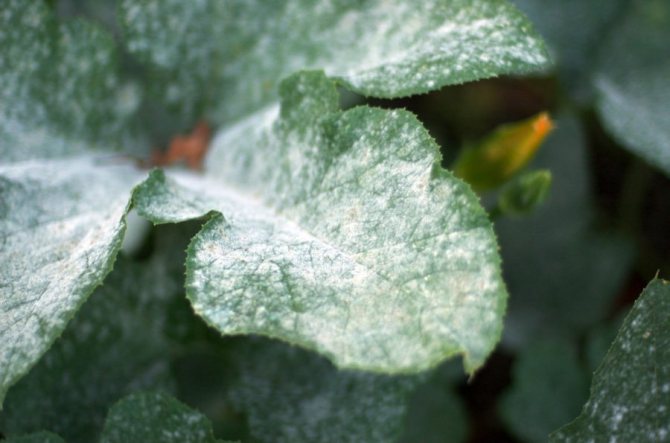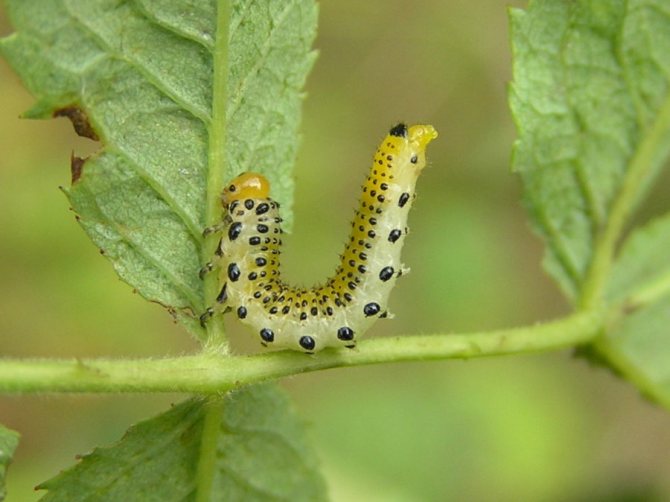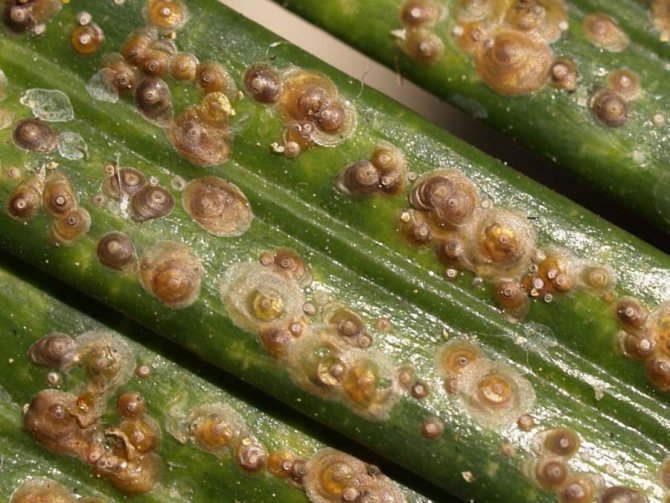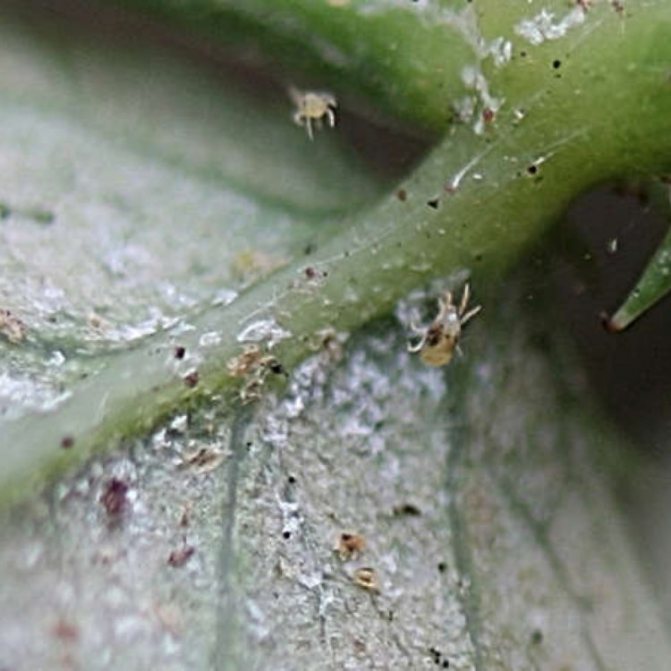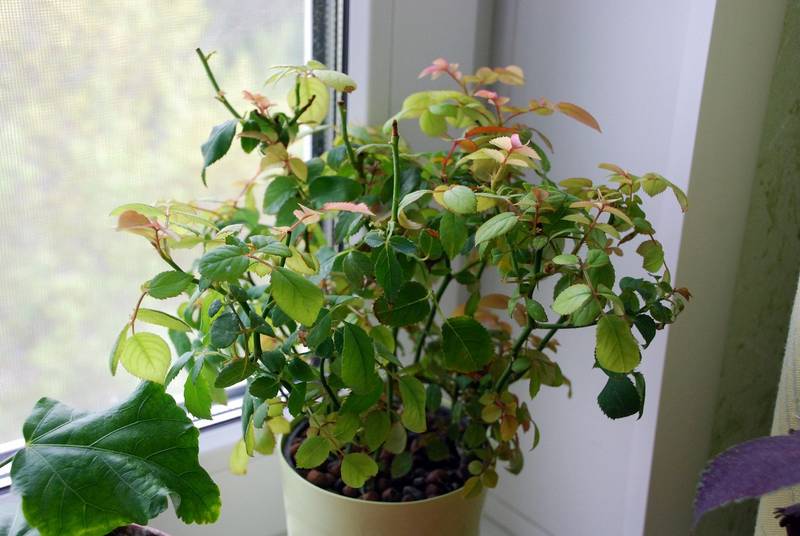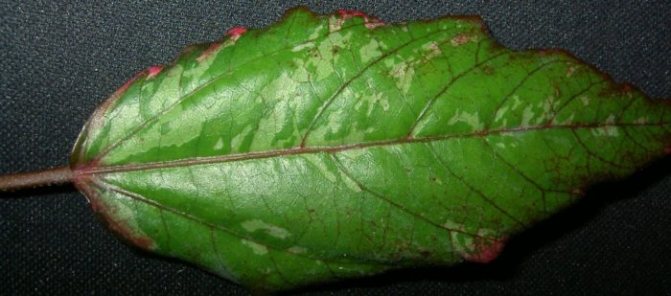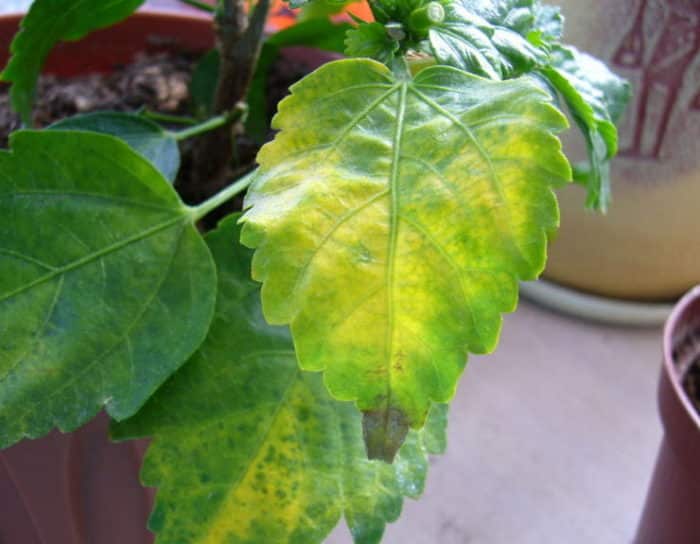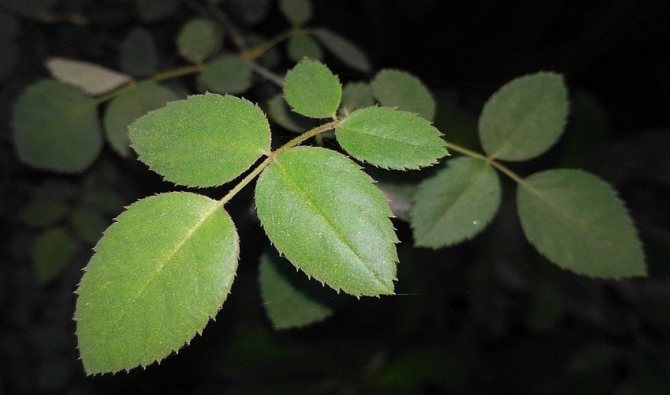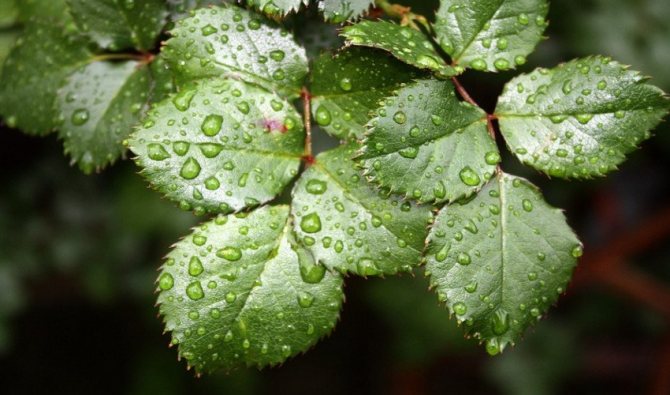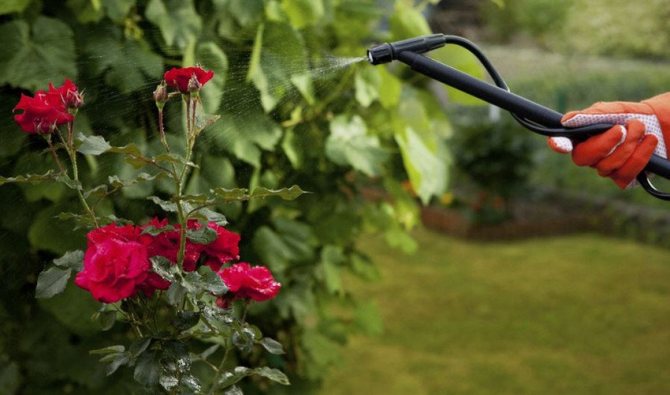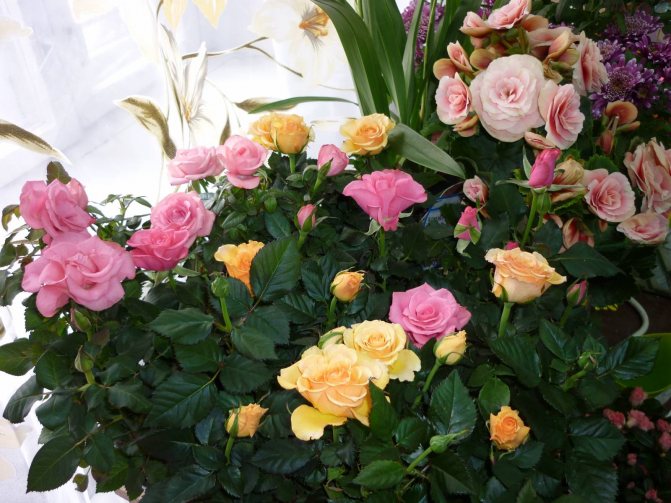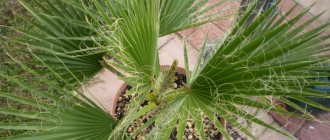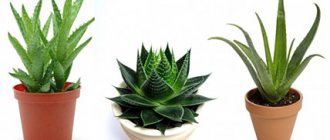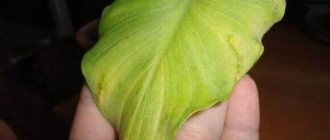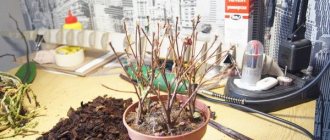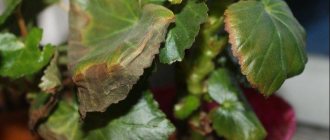Rose is a favorite flower of many gardeners. It is used to decorate gardens, parks, and private plots. As a result of the work of breeders, there are currently a large number of varieties and varieties, different colors and shades. However, the "queen of flowers" is often sick or attacked by pests. As a result, the roots, leaves or buds of the plant may be damaged. This article will consider the question of why a rose sheds its leaves, what to do for a flower lover in such cases, and how the plant can be saved.
Why do rose leaves turn yellow
Most often, yellowing of foliage is caused by the following reasons:
- Lack of mineral fertilizers. Depending on what the plant lacks, it turns yellow in different ways. When a crop needs nitrogen fertilization, it turns yellow completely, starting from the lower leaves. The introduction of universal fertilizers or urea can help. If the rose lacks iron, it begins to turn yellow in spots - from top to bottom. In this case, any acidifying fertilizer will do.
- Overfeeding. An excess of mineral fertilizers can also lead to leaf fall. When the flower is weak and you want to feed it, it is better to start with half the dose, otherwise you can burn the roots.
- Pests and diseases. Chlorosis is one of the most common diseases. You can fight it with the help of Antichlorosin, which dissolves well in water. They water the plant twice during the growth period, and then once every two weeks, if necessary.
- Excessive moisture. Although a rose loves moisture, excess is harmful to it, otherwise it will not only begin to turn yellow, but also rot. It is not difficult to find a middle ground - it is enough to carry out high-quality drainage and water the plant as soon as the top layer begins to dry. In addition, it is useful to spray it with warm water from a spray bottle.

Improper transplanting is a common cause of yellow foliage. This should be done once a year, preferably in February. The pot should be taken a little more each time. When transplanting, use the transshipment method, but very carefully so as not to damage the roots. Then the culture is transferred to heat.
Why is this happening?
The following factors can lead to yellowing of a room rose:
- Low water temperature for irrigation - you need to moisten the rose with water only at room temperature.
- Drafts. Do not place a flower near an open window.
- Infrequent watering or overflowing. The saturation of the soil with moisture must be balanced.
- Lack of fresh air. If possible, in summer, the pot should be taken out into the garden or onto the balcony, or the room should be well ventilated.
- Lack of regular feeding. Rose requires the mandatory introduction of additional nutrients into the soil.
- Incorrect transplant. Moving to a new container should be carried out as carefully as possible so as not to damage the plant.
- The defeat of the plant by rust, spider mites or thrips.
Yellow leaves on a garden rose can appear if:
- Sudden temperature changes occur.
- The rose grows in an area that is too shaded.
- The place where the rose grows is not protected from strong winds.
- The plant is not getting enough moisture.
- The prickly beauty is lacking in nutrients.
- Damage by pests or diseases has occurred.Red spider mites, aphids, pink scale insects, nematodes and black spot are harmful.
We suggest that you familiarize yourself with: Varieties of hybrid tea roses with photos and descriptions, correct pruning of rose bushes
Diseases and pests
Rose is a delicate plant, so it is susceptible to various diseases. This is, for example, powdery mildew, the symptoms of which are loss of color and leaf fall. If the climate in the room is incorrectly selected, the culture can infect the fungus.
Parasites can also damage roses. One of them is the spider mite, which requires regular treatment. Often, the leaves begin to wither and fade if larvae are in the root system. Since they multiply quickly and can kill the plant, you have to use an insecticide. After a month, re-processing is carried out.


To preserve the flower, it is better to immediately transplant it from the store soil into your own. Before planting, the soil must be warmed up in the oven or held in the freezer.
What else affects the yellowing of the leaves
What does wrong watering mean? It is strictly forbidden to water the rose garden with ice and even cold water. It is advisable that it is not hard - if possible, collect rainwater. You need to water the rose as the soil dries out, in the heat the amount of watering should be increased. The best time to water on sunny days is in the morning when the sun is low or in the evening after sunset. Watering in hot weather will cause burns and brown spots on the leaves.
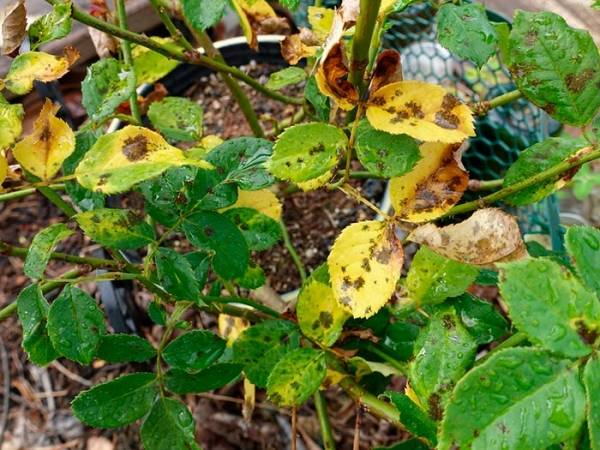

Another reason why a rose loses its foliage color is also related to watering. But overkill this time. The soil should be inspected, if it is constantly wet - the flower is "flooded". In constant dampness, yellowing and rot of the green parts of the flower are inevitable. The same will happen with a lack of moisture. It is impossible to overdry the soil - in order to prevent the formation of a dry crust, it must be "diluted" with sawdust, small expanded clay and, of course, loosened.
The rose is sun-loving, so the lack of lighting will also manifest itself as yellowing of the leaves. It is advisable to transplant it to a sunnier place, or regularly cut the lower part of the rose bush. This will provide more sunlight for the plant. If planting a rose is planned in a shady place, you can pick up shade-loving varieties.
Excessive foliage can also ruin the color - the plant needs frequent pruning. And it is better to plant bushes away from each other.
The rose is a royal among the flower family. Capricious enough, but with proper care, it will bloom magnificently and delight with green foliage. Practical advice and a detailed description of the causes of the "ailment" will help prevent its yellowing.
Malnutrition
If diseases and pests are not detected, but the rose continues to turn yellow, the cause may be a lack of nutrients. By the color of the leaves, you can understand what the bush is missing, feed it.
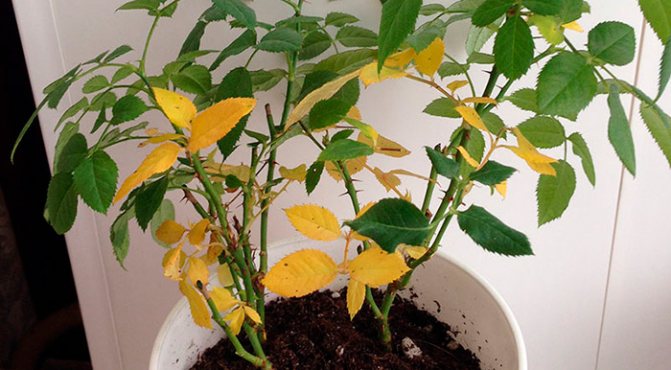

It is especially important to fertilize the plant during the flowering period. If this is not done, the buds will be sparse, and the leaves will turn yellow, dry and wither.
Yellowing of roses with a lack of nutrients in the soil
Many people ask this question, why do the leaves of a rose turn yellow? Often the reason for this is the insufficient amount of nutrients in the soil:
- Lack of nitrogen is characterized by faded and wilted leaves.
- With a low content of phosphorus in the soil, not only the ground part is affected, but also the rhizome. An excess of this substance is also undesirable.
- Potassium is responsible for the duration and intensity of flowering. Its insufficient amount is manifested in the appearance of brown, yellow spots on the leaves.
- Chlorosis is triggered by a lack of iron in the soil. The first signs are yellowing of the leaf.
Improper watering
If you water the flowers incorrectly, you can seriously harm them. Do not use cold water to water the rose.From this, the bush gets sick, stops growing and eventually dies. The water should be soft and settled. Some growers advise boiling it.
The frequency of watering can be selected according to the state of the soil in the pot. If its top layer begins to crack, moisture is needed. Adult plants are watered two or three times a week. In the summer heat, you can water them more often and install a humidifier in the room.
Incorrectly selected pot or soil when replanting
To transplant a rose, remove it from the previous pot along with an earthen ball. Assess the condition of the roots surrounding the earth.
If the roots are thin, like hair, brown or blackened, dry or rotten, then the plant is likely to die. You can make an attempt to save him: cut the cuttings and try to root them.
Healthy roots are bright white or yellowish in color and look quite dense, like a thin wire. If the roots are only partially missing, you need to remove all rotten and damaged ones, leaving healthy ones.
Pour expanded clay or other drainage at the bottom of the new pot.
It is better to buy a soil mixture ready for roses or garden. Do not take cheap soil, it contains a lot of peat and few useful substances. Better to choose a better quality potting mix.
Cover the drainage with earth, compact a little. Place the rose bush together with an earthen lump, cover with new earth, periodically compacting it so that the bush does not hang out in the pot, but is well fixed. Pour with settled or filtered water at room temperature.
Treatment for diseases and pests is necessary. A pruned and transplanted plant is weakened and susceptible to disease, even if it has been well cared for in the store and has not been contaminated. Therefore, it is better to play it safe and process it.
Also, after transplanting, treatment with Epin is effective - it will strengthen the plant's immunity and reduce the stress from transplanting.
Spray your plant, it needs high humidity, especially in conditions of working heating and dry air in the apartment. If the rose is very small and weak, then the pot can be covered with a bottle on top (with small holes), creating a greenhouse, and only then gradually accustom the rose to the apartment air.
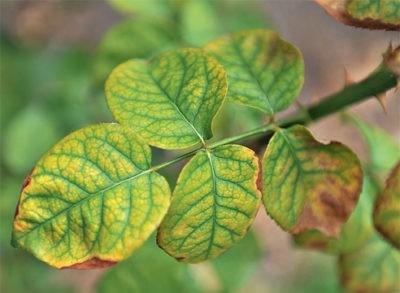

Then we place the pot with the transplanted plant in a well-lit place. If you have a shady side and there is not enough light in winter, supplement the rose with fluorescent lamps.
Often, the leaves of a flower turn yellow due to a lack of moisture in the soil. Overdried soil and the appearance of a crust with cracks on its upper layer is a sure sign of a lack of watering. It is worth noting that it is worth watering the rose regularly. The reference point should be the condition of the soil: if the substrate is wet and does not have cracks, then it is too early to water.
As a rule, an adult indoor rose bush requires watering two to three times a week, or even 10 days. In a hot and dry season, it is worth placing a humidifier in the room and watering more often than usual. One of the reasons why leaves begin to crumble and dry is watering with cold water. This makes the plant sick, and over time it can stop growing and die. It is worth watering with settled and soft water, some experts recommend boiling it for watering.
A correctly chosen substrate for a flower room queen is one of the most important conditions for her active growth and flowering. For transplanting, it is better to purchase a ready-made mixture specifically for roses; experts also advise a substrate for violets. When in the ground, where there is not enough air and nutrients, the foliage of the shrub may turn yellow.
- 1 part of coarse river sand;
- 1 part charcoal;
- 4 parts of peat;
- 4 parts of turf land.
And, of course, do not forget about drainage, it is simply necessary for good growth and healthy existence of the flower.
Roses should be transplanted into neutral soil.You can buy it in specialized stores where they sell special soil for roses. Using an acidic or alkaline substrate will result in yellow foliage.
The pot should also be chosen carefully. The new container should be only 2-3 cm larger than the old one. Drainage must be poured into the bottom of the pot.
The transplant is carried out by the transshipment method so that the plant undergoes the procedure painlessly.
After transplanting, the flower should stand in the shade for two or three days.
Other reasons
In addition to the above reasons, other factors can cause yellowing:
- High room temperature or lack of light.
- Sunburn. The appearance of yellow and brown spots on the leaves may indicate spraying with cold water in the sun or excess sunlight. If this happens, the pot needs to be rearranged.
- Drafts are the main enemies of indoor flowers. If the plant freezes, it will begin to turn yellow and shed its leaves. A screen made of paper or plastic can help to protect the culture.
There are also such varieties of roses in which the yellowing of the leaves is a signal of preparation for winter, therefore, a change in color does not always indicate a disease or the appearance of pests - do not panic. If, when buying such a beauty as a room rose, you find out all the rules for caring for it, it will be much less capricious.
Flowers for a true lover to grow them are a source of joy and well-deserved pride. But if problems arise, this cannot but cause chagrin. You can understand and understand why the leaves of a rose turn yellow, what caused such a misfortune on your favorite plant, by reading and studying this text.
Preventive measures
Why do the leaves of a rose turn red
In order for your favorite flowers to grow magnificently and delight the eye, you need to take care of proper care. In addition, it is imperative to take preventive measures. It is easier to prevent diseases than to cure them later.
Preventive methods in caring for rose plantations are in the right place for planting. Plant in well-lit and ventilated areas, on fertile soils, having prepared the place in advance.
Timely feeding with mineral and organic fertilizers is very important. Without dressing, flowering will not be lush.
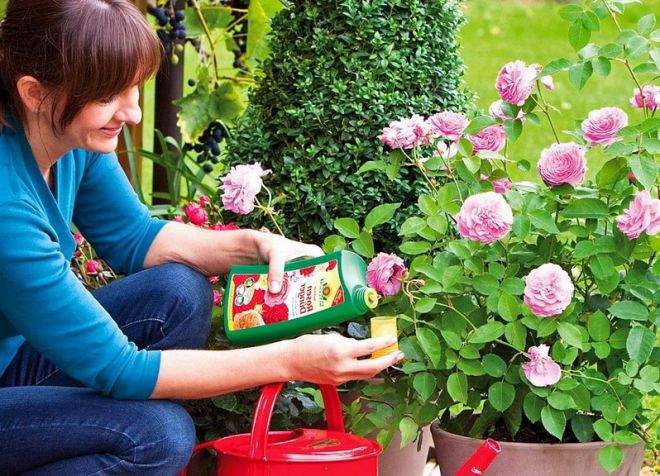

Fertilizing roses
Make sure that pests and diseases do not appear. Even a cursory examination of the stems reveals the problem.
Correct and timely pruning of the stems is necessary so that the rose garden is well ventilated and illuminated by the sun.
General rules for caring for roses in the open field and at home
Caring for rose bushes is quite laborious, since the plants are demanding and not all varieties have good resistance to diseases and pests.
Caring for roses at home
Landing
Roses should be planted in open ground in the fall, while it is necessary to choose the right timing, if planting too early, the bush will begin to give new shoots, which can die in frosts. A delay in planting is also undesirable, since the plant will not have time to take root. Then the rose is cut, removing all weak branches, and leaving 5-7 buds on strong ones. The bush is watered, spud and mulched. After the onset of the first light frosts, the rose is covered.
"Overfeeding or underfeeding" - what fertilizers does a rose need
Unfortunately, flowers cannot explain to people what "hurts" they have. They tell about the presence of a problem with "signs", it is important to understand them correctly. If the leaves of the rose turn yellow, this may be a signal that the flower is starving. The beauty is gentle and capricious, she needs regular feeding - minerals and organics. In the case of a lack of them, the leaves will turn yellow. Basic mineral fertilizers:
- Nitrogenous fertilizers. It is necessary not to miss the moment and feed the rose at the stage of recruitment of growth and overgrowth with foliage. In the absence of nitrogen, the leaves will begin to turn yellow and fall off. The rose bush will be frail and aesthetically unattractive. Overfeeding can deprive a rose of flowering, a bush with dense foliage will grow.For proper feeding, you can use the recipe: 30 g of urea per bucket of water.
- Potassium-phosphorus supplements. Lack of this nutrient mixture prevents the rose from budding. Or, on the contrary, they will fall off even before disclosure. If a flower lacks potassium, it will “signal” the appearance of yellow spots on the foliage.
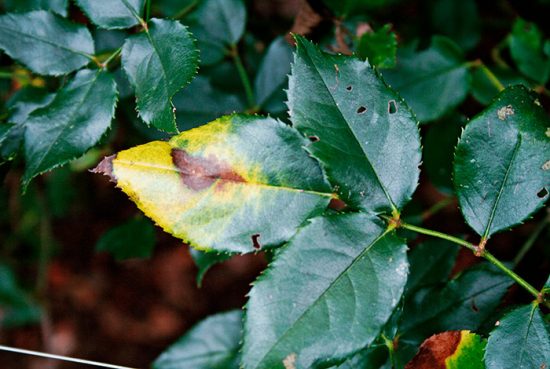

- Leaves also turn yellow from a lack of iron, magnesium, manganese. Chlorosis develops. Young foliage turns yellow entirely, larger leaves - gradually, losing color and falling off. For a balanced feeding, you can use complex formulations, strictly adhering to the norms.
Attention! It is not recommended to use only mineral dressings - their action is faster, but without organic matter, the rose will get sick over time.
Organic fertilizers are always available. These are manure, peat, herbal infusions, compost. You shouldn't use just one, you need to alternate them. Fresh manure is also not desirable, it can burn the roots. In the first year, the rose is not fed, provided that an organic composition has been previously introduced into the planting pit.
Why and what to do if the leaves of a garden rose turn yellow and fall
Important! If a gardener notices that a rose is turning yellow and leaves are falling, what should he do? First you need to try to establish the cause.
There are various reasons for yellowing:
- lack or excess of nutrients;
- improper watering;
- illness;
- harmful insects.
Each of these reasons will be indicated by the nature of the yellowing.
Why do the leaves of a rose turn yellow
Lack or excess of nutrients
If the lower leaves began to turn yellow and fall off, the bush forms few buds, the flower petals are small, and the young growths are weak - all this indicates a lack of nitrogen. You should not wait until the bush turns yellow completely and begins to shed its leaves; if one or more of these signs are found, the plant is immediately fed with ammonium nitrate or special complexes for roses containing nitrogen.
An explanation of why the leaves of a rose in a garden turn yellow in summer may be a lack of potassium, but in this case, the tips of the leaves turn yellow and then dry out. If you do not feed the plant with potassium sulfate or potassium magnesia, it will dry out completely. Top dressing is carried out with a solution of a substance at the rate of half a tablespoon per 5 liters of water.
Note! If yellowness appears in the center of the leaf between the veins, then it is possible that the soil under the rose is acidic, you need to add ash or dolomite flour.
When the leaves partially turn red, and then these places die off and can completely fall off, this indicates a lack of magnesium. When watering with water, it is recommended to add magnesium sulfate (10-12 g per 5 liters of water).
With a lack of iron, the entire leaf plate turns yellow, only green color remains along the veins. If you do not take action, foliage falls. Recommended top dressing is Fertika Universal-2, and next year in spring apply Pokon for roses according to the instructions on the package.
The leaf may not turn yellow entirely, but in the form of an arrow from the edge to the center, this is the result of manganese deficiency. Spraying with manganese sulfate can help, and next spring root top dressing with Fertika Universal-2 is recommended.
Advice! If the gardener regularly conducts the necessary dressing, and yellowness is still present, it is worth testing the soil for acidity. This can be caused by both high and low pH values. The soil should be made neutral in acidity.
Watering
Due to the lack of moisture, the leaves dry and curl, and the buds droop. It is necessary to carry out regular watering and mulch the soil around the bush.
Due to waterlogging, the foliage turns yellow, as if there is a lack of nitrogen. You just need to reduce the frequency of watering, and in case of long rains, try to cover the flower bed with a film, add sand and remove the lower leaves and shoots.
Diseases
Infectious diseases of roses and their treatment are presented in the table:
| Infection | Type of defeat | Treatment |
| Black spot | The leaf becomes covered with black spots, yellowness forms around them. | Removal of yellow leaves, irrigation of the bush with Bordeaux liquid, Oxyhom. |
| Schaceloma | Red spots on foliage, then yellowing and dropping. | Cut off the affected leaves, treat with Oxyhom, Topsin-M |
| Bacterial disease - root cancer | The whole bush turns yellow, complete foliage fall, deformation of the branches. | The bush should be dug up. If the root is not completely affected, cut off the affected areas, treat the root with Phytolavin. If the root is completely damaged, the bush must be burned. |
| Various rot | Yellow leaves, gray bloom. | Removal of affected shoots, treatment with Fitolovin. |
| Viral diseases | The foliage is covered with spots of different colors, becomes smaller, the bush does not bloom. | The virus-infected bush is immediately removed and burned. |
Pests
The most common of them: sawfly, rose leafhopper, aphid, spider mite, leafworm, orange whitefly.
When infected by insects, traces of damage first appear on the leaves, then yellowing. Pest control should be done by carefully removing the affected shoots and spraying the plants with special preparations.
Attention! The appearance of aphids on roses may be due to excess nitrogen. When applying dressings, overdose should not be allowed.
Rose leafhopper is also dangerous because it carries viruses. When hot, this insect spreads especially quickly. They are light yellow insects with wings and can be found underneath the leaf. Eliminate the problem by destroying insects and treating plants with Fitoverm, Aktara insecticides.
Advice! If you add 1 spoon of alcohol to 1 liter of working solution, the effectiveness of the product will significantly increase.
Soreness of indoor plants
A rose will hurt only if it is not properly cared for or neglected altogether. Yellowing, redness and wilting of foliage in some cases indicate the presence of disease. Most often, these can be such problems: rust, thrips, powdery mildew and a disease associated with the defeat of the plant by a spider mite.
Rust affects young shoots and leaves. It looks like yellow bumps on the shoots and like orange spots on the underside of the leaf. Then yellow and red spots appear on the upper side of the leaf, expanding to its entire surface. Rust can appear if the rose is in an unventilated room, the soil was too waterlogged, or the air temperature was not normal. For treatment, first of all, it is necessary to remove all rusty shoots, treat it with a fungicide solution and start proper rose care.
Improper watering can lead to yellowing of the foliage system. It is highly undesirable to allow the soil to dry out. The flower is watered as the top layer of the soil in the pot dries up. It is impossible to water the rose with cold water, the water in the pan should also not stagnate. Watering can be done both in the pallet and from above.
If the air is too dry and its temperature is high, the plant can infect thrips. In this case, the upper side of the leaves takes on a yellow tint with a silvery sheen. In severe cases, the foliage becomes brown and falls off. For a complete recovery, the rose must be sprayed with an insecticide solution, and also create an optimal temperature regime.
Powdery mildew is a plant disease of a fungal nature. The reasons for the appearance lie in a lack of fresh air, an excess of fertilizer, excessive heat and moisture. In case of damage, the upper surface of the leaf is covered with spots of a yellow or red hue. Leaves can curl and fall off. First, it is necessary to remove absolutely all affected leaves and shoots of the rose. Secondly, as in the case of combating rust, the flower is treated with a solution of fungicides.
The spider mite affects both the upper and lower sides of the leaf.This disease is characterized by the appearance of pale dots on the affected leaves. This is due to the fact that the parasite takes all the cell sap from the flower. Such points tend to grow to faint spots on the entire surface of the leaves.
Soon the foliage falls off altogether. The cause of this disease is dry and too hot air in the room where the indoor plants are located. To combat this parasite, you need to clear the plant from the cobwebs, and then spray it with a solution called Fitoverm. Of course, roses are whimsical indoor plants. Nevertheless, proper care and timely treatment is the key to a healthy plant.
Most often, the leaves of a rose bush turn yellow; also, due to an ailment, the color can change the stem and flowers. Moreover, on flowers, yellowness looks more like rusty spots.
The yellowed rose bush loses its decorative effect. Often this ailment is accompanied by the loss of leaves. The rose can stop growing, often the deformation of the shoots occurs. As a result, the plant dries up and dies.
Flowers
Prophylaxis
Preventive measures include:
- competent feeding;
- correct organization of watering;
- timely treatment of roses from diseases;
- spraying with insecticides;
- selection of a site for planting, taking into account the characteristics of the soil;
- the formation of bushes without thickening.
Spraying roses with insecticides
When planning a rose garden in the country, you should definitely be guided by the recommended schemes. Climbing roses are placed after 1.5 meters, spray roses - after 0.5 meters, mini-roses - after 30 cm. This is necessary not only for the decorative effect, but also for the prevention of diseases.
When purchasing a rose seedling, you need to study all the features of the variety. There are varieties in which the leaves turn yellow in preparation for winter, this is absolutely normal and should not cause alarm.
Breeding roses in a summer cottage or at home is a fascinating business, if all the rules are followed and prevention is carried out, it will not create problems and will bring a lot of joy.
At a room rose, leaves turn yellow and fall for several reasons, most often due to mistakes in care. The rose is a chic but finicky flower. Therefore, before starting treatment, it is not enough just to remove yellowed and fallen leaves, but you need to find out the cause of the disease and clearly understand how to cure the plant. It is more difficult when the foliage crumbles from a donated flower, but this problem can be solved by studying all the nuances of care. So, what to do if the leaves of a room rose turn yellow and fall off in this article.
Lack of fertilizer or incorrect feeding
The soil for this plant should contain a considerable amount of nutrients. Therefore, regular feeding of the flower is carried out. Often, the leaves of a room rose begin to turn yellow for this very reason. Lack of calcium and iron in the substrate is manifested precisely by foliar disease. You can determine this exactly by the localization of yellow spots: the leaf begins to turn yellow in the space between the veins, then gradually the entire surface becomes light.
To solve this problem, it is worth immediately feeding the home flower, the fertilizer should contain iron and calcium. Of course, it is better for the plant if the fertilizer is complex. It should be brought in one week after the transplant, and as usual - once every 3 weeks. Nitrogen deficiency also leads to leaf disease.
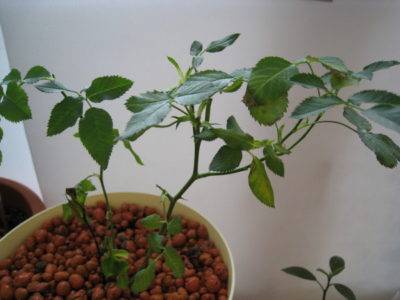

Due to the lack of this nutrient, metabolism is disturbed and the plant begins to ache. Quite often, the leaves can turn yellow in the midst of flowering bush. There is a completely logical explanation for this: during this period, the rose actively feeds and spends a lot of energy on flowering, so the soil is depleted. Top dressing at this moment will be very useful and timely for the flower. You need to be very careful about the amount of fertilizers; an excess of them can lead to new problems.
Causes of yellowing and falling leaves in a room rose
There are a number of factors why the leaves of a rose turn yellow. Very often this happens due to burns from the scorching sun. In this case, you need to rearrange the plant in a place where direct rays of the sun cannot fall on it. After a while, the state of the flower will return to normal. In addition, the leaves of the rose fall and change their color due to:
- improper watering;
- excess or lack of nutrients;
- untimely transplant;
- unsuitable soil;
- drafts;
- insufficient lighting;
- diseases and pests.
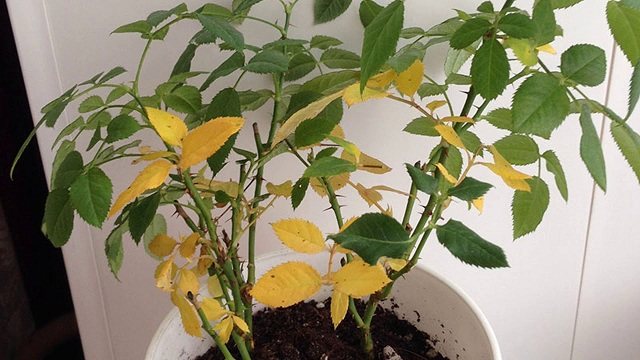

Soil condition
In a home rose, leaves turn yellow and fall off due to improperly selected soil. The plant prefers light, nutritious soil that allows air to pass through well. Therefore, if the leaves turn yellow for this reason, the flower must be transplanted. For this, it is recommended to purchase a substrate specifically designed for roses.
You can prepare the desired soil mixture yourself by mixing 1 part of coarse sand, charcoal and 4 parts of peat and sod soil. When transplanting, be sure to use drainage.
The earth must not be allowed to dry out. Lack of moisture can also be the reason that the leaves of a room rose turn yellow and fall off. It is necessary to regularly water the flower, focusing on the state of the earth in the pot. If it is wet, watering is not needed. It is recommended to water the rose 2-3 times every 7-10 days. In summer, in hot weather, the amount of watering should be increased, and the air in the room with the flower should also be humidified.
Do not use cold water for irrigation. This can also contribute to the fact that the leaves of the rose dry and fall. In addition, it can lead to disease and even death of the rose bush. For watering, you need to use soft, well-separated for several days, room temperature water.
Lack of fertilizer or incorrect feeding
Indoor roses need nutrients for healthy growth and development. Therefore, the flower needs to be fertilized regularly. Mostly rose leaves turn yellow due to:
- Lack of iron and calcium. Leaf diseases indicate their lack. Yellowing appears on the foliage between the veins, then the surface brightens completely. In this case, you need to feed the rose with complex fertilizers, which must include iron and calcium. If the plant has been transplanted, you need to fertilize it after a week. In the future, fertilizers are applied every three weeks.
- Lack of nitrogen. Its lack leads to metabolic disorders, and the flower gets sick. Depletion of the soil can lead to yellowing of the foliage. Nitrogen is introduced during the flowering period, when the rose needs a lot of strength and nutrition. At this time, top dressing should be applied in a timely manner.
It is important not to overfeed the flower. Excess fertilizer also has a detrimental effect on indoor rose.
Habitat changes
The condition of indoor plants is strongly influenced by changes in location and climatic conditions. Therefore, when purchasing a rose, you need to ask what conditions are suitable for him. Important:
- Keep the flower away from heaters and batteries. Potted roses, the foliage of which dries and turns yellow due to too dry air and heat, can dry out completely.
- Avoid direct sunlight on the plant, which burns the petals and foliage, which as a result becomes brown or yellow.
- Make sure that the room with the rose is not too hot or cold. In the warm season, it is good to take the flower to fresh air. With the arrival of the cold, it must be removed to the room. Being in a place with a very low temperature, the rose will begin to shed foliage and flowers, flowering will stop.
- The rosette must be protected from drafts, which can also cause the tips of the leaves to dry out and the foliage to turn yellow.
- The room in which the flower is located should be well lit.Therefore, in the autumn-winter period, it is recommended to use artificial light devices in order to extend the daylight hours.
Factors detrimental to flower development
First you need to figure out why the leaves of a room rose turn yellow. Often, to solve such a problem, it is enough to rearrange the pot to another place where there is no direct exposure to sunlight - then the state of the flower will return to normal. But it happens that the reasons for the yellowing of the leaves lie in other unfavorable conditions for the development of the plant.
Unfavorable factors for roses
- Watering with too cold water - watered with water at room temperature.
- Drafts - it is recommended not to keep the plant under an open window.
- Abundant or, on the contrary, rare watering - the rose needs an optimal moisture content in the soil.
- Lack of fresh air - in summer you need to take the pot out to the balcony or terrace.
- Lack of nutrients - the rose definitely needs regular feeding.
- Incorrect transplantation - if you need to move the plant into a large container, you need to do this with the utmost care, and choose a month for such actions - February. In this case, the rose has a better chance of taking root.
- Powdery mildew is a white bloom that appears with over-fertilization or lack of fresh air.
- Rust - looks like bumps. The reasons for its appearance are abundant watering, high temperature in the room.
- Thrips - appears at low humidity, it gives the leaves a gray-yellow color.
- Spider mite - provoked by too dry air or not enough space for plants.
Diseases of the rose
Before proceeding with the treatment of roses, it is necessary to determine whether the foliage turns yellow due to illness or due to natural aging reasons. They are often confused due to similar symptoms. First, the leaves at the bottom of the bush begin to turn yellow. Then they become covered with dark spots, which gradually increase, dry up and fall off. If the leaves of a room rose turn yellow and fall off due to aging, one or two leaves are lost. If there are a lot of yellowed foliage, the cause may be diseases, among which the most common are:
- Powdery mildew, a symptom of which is a white coating on the foliage surface. With delayed treatment, it spreads to flowers and stems. Insufficient ventilation and excessive feeding contribute to its appearance. If signs of disease are found, it is necessary to remove the infected areas and treat the rose with a fungicide.
- Rust appears due to waterlogging, insufficient ventilation and very high temperatures. It is indicated by yellow or red spots on the leaves, leading to falling off. In this case, a fungicide is used to treat the rose.
- Black spot, signs of which include yellowing of the leaves and the formation of dark spots on them. The infected plant is treated with a fungicide.
- Viral diseases. Unfortunately, they are not curable, so you will have to get rid of the rose.
The main cause of home rose diseases is improper care. Therefore, in order to avoid problems, when caring for a flower, you must adhere to certain rules and apply the recommendations of professionals in floriculture.
When is it natural and when is it not?
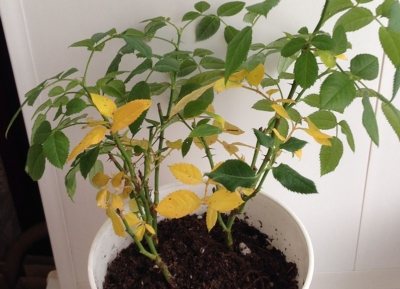

If in the fall or after the end of the vegetative period, the leaves and faded buds of a room rose gradually dry up and fall off, then there is no reason for panic - this is a natural physiological process. This process is necessary for the rose to renew itself and enter the resting stage.
An unnatural fall is considered:
- Loss of leaves in the spring and summer.
- Yellowing and falling leaves on only one side of the flower.
- The appearance on the leaves of black spots, red veins, white bloom.
If such a situation arises, it is necessary to help the flower as soon as possible.
Rose pests
A common reason leading to the leaves turning yellow in a room rose may be damage to the flower by harmful insects.The most frequent guests are:
- Spider mite, which appears due to dry and hot air in the room. Its appearance is indicated by subtle dots and a cobweb enveloping the leaves and stems. To get rid of the parasite, you should clean the rose with soapy water and treat it with an insecticide. Repeat the procedure after 10 days. The soil is also worth tilling. In order to prevent it in a room with a rose, it is necessary to lower the air temperature and increase the humidity, as well as spray the bush more often.
- Thrips, the signs of which are a silvery coating on the leaves, the foliage acquires a slightly yellowish color. Formed due to elevated temperatures and dry air. If they are found, it is necessary to increase the humidity of the air, treat the flower together with the soil with an insecticide.
- Rose cicada appears due to hot dry air. Pale specks form on the foliage. Then the foliage turns yellow and falls off. For treatment, the bush should be treated with soapy water and an insecticide.
- Pests affecting the root system of roses. The leaves turn pale and wither. Young leaves grow deformed. The soil must be treated with a special systemic insecticide twice with a break of 30 days.
It is important to transplant purchased indoor roses immediately after they have adapted to the new conditions into fresh soil, which should be previously disinfected by freezing or heating in the oven.
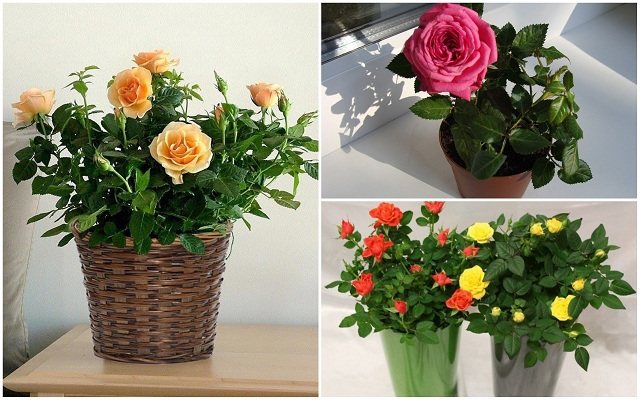

Why does it drop buds and how to help a potted plant?
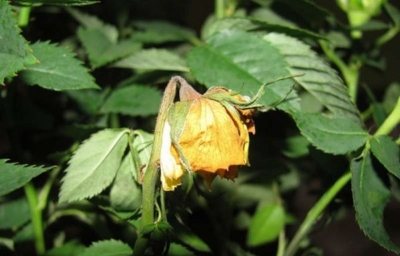

Reasons why indoor rose sheds buds:
- Cold or draft in the room.
- Use for cold water irrigation.
- Transplant a rose when it has buds.
- Irregular watering.
- Depletion of soil in a pot.
- Oversupply of fertilizers.
- A sharp change in air temperature and humidity level.
- Damage to the plant by pests.
To help the plant, you need:
- Check leaves and stems for pests. If they are found, it is worth treating the plant as soon as possible.
- Analyze the care of the plant. It is possible that mistakes were made in the form of irregular watering, improper fertilization, or violation of the light regime. Correcting these errors will help the plant recover.
- Remove the rose in a warm, draft-free room.
- Water with separated water at a temperature room.
Other reasons
When growing a room queen, you need to know that the rose sheds its leaves during dormancy or before preparing for wintering. In the spring, she will again increase the green mass. This does not apply to all varieties, therefore, when purchasing a rose, you need to familiarize yourself with its varietal characteristics, perhaps it belongs to deciduous. If not, then several other factors leading to yellowing and foliage may be:
- Insufficient lighting. For the rose to feel good, you need to provide it with 5-6 hours of exposure to the sun, but so that it is not burned by direct sunlight. The best place for it will be windows facing the west or southwest sides. In spring and summer, you can keep the rose on the balcony or place it with a flowerpot in open ground.
- Dry indoor air with a plant. In warm weather, the flower should be sprayed. On hot days, it is recommended to spray twice a day: in the morning and in the evening. No spraying is needed during the winter season. A container filled with water can be placed next to the rose. It is good to rinse the rose once a week under a warm light shower.
- Drafts, especially cold ones, are also a contributing factor to yellowing and leaf fall. Therefore, it is necessary to provide the rose with protection from them.
- Burns due to direct sunlight hitting the flower, as a result of which the leaves dry out and fall off. In this case, the rose must be rearranged.
When purchasing a plant, you must definitely learn how to care for roses and what to do when they wither. Observing the rules of care and taking good care of indoor beauties, you do not need to worry about the condition of the plants.They will undoubtedly delight with their healthy appearance and flowering. And it's important to remember that improper care can be problematic.
How to save a rose, see the video:
Habitat changes
It is no secret that in flower shops and salons a certain temperature regime is observed, the level of humidity in the air, and special dressings are made for active flowering. When purchasing a rose, it is worth asking what conditions it is used to.
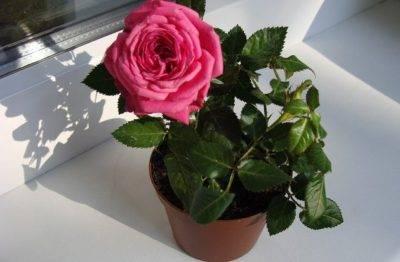

The most common answer to the question of why the leaves of a rose turn yellow is poor acclimatization after a change in growth conditions. It is worth remembering that you cannot put a flower pot near heaters and batteries: from heat and dry air, not only leaves can fall off, but the bush itself can dry out. You cannot place the plant on a windowsill from the sunny side. Direct sunlight causes leaf burns, which can cause them to turn yellow or brown. Just like heat, cold is harmful to flowers. In winter, the rosette should not be on the balcony or loggia; with the onset of cold weather, it is brought into a warm room.
These flowers are afraid of drafts, especially if they are cold. Falling foliage, stopping flowering and dropping flowers are far from all the possible consequences of too low a temperature. Poor lighting in winter can be one of the possible causes of rose disease. There should be enough sunlight in the room. To remedy the situation, it is necessary to create artificial lighting for the flowers and extend it for several hours relative to natural.
Often, the rose bush dries up and gets sick due to its growth. In an old flowerpot, the root system can already be quite crowded, so the plant begins to slow down its growth and sheds foliage.
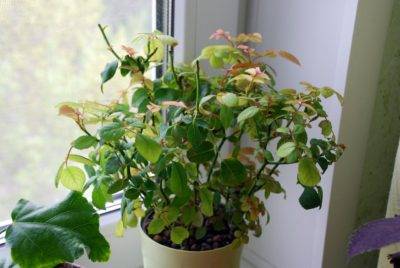

How to save a flower
- 1 Remove from the bush all leaves that are darkened and eaten by insects. Those under which cobwebs are found - also cut off.
- 2Treat the bush with special preparations (Fitoverm).
If the fight against parasites and the improvement of conditions, the quality of care did not help, then you need to check the condition of the roots. They rot due to excess moisture, or high soil density. After examining them, it is worth removing all tainted parts. Then - rinse with a solution of potassium permanganate and treat with an antifungal drug.
Do not forget about fertilizing the flower pot: once every 2 weeks if the rose is sick. As it recovers, the frequency of feeding is reduced. Healthy flowers are fertilized twice a year. In the spring, fertilizers containing potassium and nitrogen are needed.
Strong yellowness of the leaves is a sign of chlorosis (lack of iron). Accordingly, it is required to make dressings containing this element.
Periodic pruning of the plant will also benefit him. Without urgent need, this procedure is carried out in the spring and late autumn after flowering.
Do not transplant a rose for no reason. This is done if:
- the old flower garden is already small;
- the plant needs urgent resuscitation, soil change.
After resettlement, the flower should be watered and removed briefly in the shade. A month after that, top dressing is carried out.
Compliance with the basic care requirements will help the rose stay healthy. It is necessary and to take measures to improve its condition and immediately after purchase.
Usually, when eliminating errors in care, hibiscus pleases for a long time with abundant and long flowering. But what to do with crumbling buds and how to restore a flower? If the bud fall is massive, it is necessary to prune the entire plant. Dried leaves and flowers should be removed, and each shoot should be shortened by 10 cm - this procedure stimulates the tree to plant new buds and promotes early flowering.
If the hibiscus is affected by pests, then thorough disinfection with insecticides is necessary. If aphids are damaged, the flower must be washed with running water or soapy water, and then treated with a special preparation.When the roots decay, the plant is removed from the pot, all spoiled roots are cut off, and the cut points are disinfected with a solution of potassium permanganate or sprinkled with coal. In this form, the hibiscus is transplanted into a new pot with a completely renewed substrate.
Rust
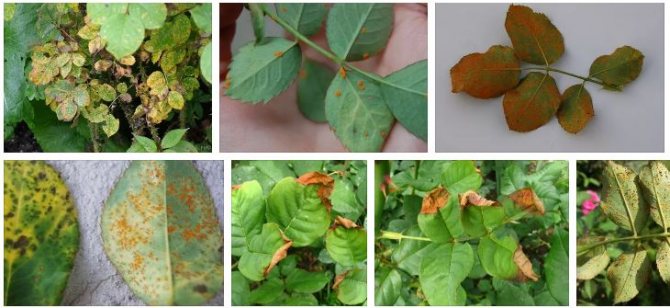

Signs of the manifestation of the disease:
- on the back of the leaf, orange tubercles appear, they rapidly increase.
- The reverse side of the sheet is covered with a rusty coating.
How to deal with rust on roses?
This is very difficult to do. Only complete removal of all leaves will help.
- The bushes are treated with copper-containing preparations: bordeaux liquid;
- copper sulfate;
- biological preparation Fitosporin.
Care errors
Symptoms The rosette dries up, sheds its leaves, the buds wither, the ends of the shoots turn brown, dry up.
Cause. Insufficient watering, low air humidity.
Treatment. Cut off all dried branches to a height of 3-4 cm from the main trunk, as well as all dry branches and yellowed leaves. Water the rose, place the pot under a plastic bag to ensure high humidity under the shelter. When new shoots appear, start airing the greenhouse, accustom the rose to dry air. If the rose has wilted but hasn't shed its leaves, try dipping the entire pot in water for 5 minutes and spraying the plant, or even soaking it whole for 2 hours in a bath, wrapping the pot in a plastic bag. If symptoms appear in the fall, don't worry - the rose is getting ready for winter.
Symptoms The rosette dries up, sheds its leaves, the buds wither, the shoots turn brown, rot.
Cause. Too much watering, frequent spraying in a cold room.
Treatment. It is more difficult to reanimate a rose that has been "filled" than "underfilled". It is necessary to remove it from the pot, clear the roots from the earth and inspect - if not all are rotten, the damaged ones are cut and transplanted into new soil (the old one may be sour), watered moderately, but not allowing the coma to dry out completely.
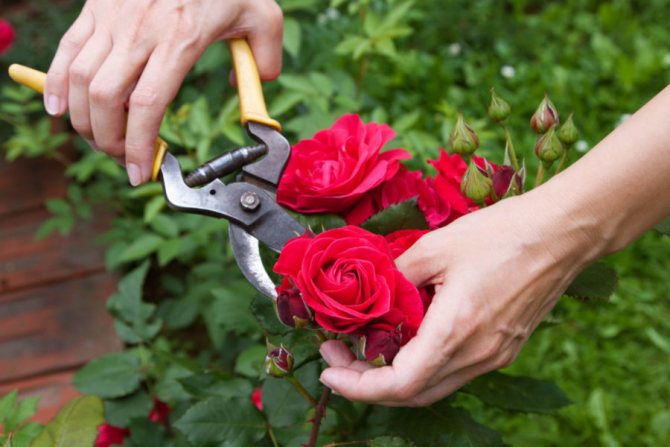

Mosaic
A viral disease manifests itself in the appearance of yellowish stains on the leaves.


Is it possible to get rid of the mosaic on the roses?
- Viral diseases are not amenable to treatment.
- Strong pruning can be done to remove all infected leaves.
- Process several times with Skor, Ridomil and Strobi.
In any case, if the plant receives enough nutrition, looks quite strong, then you do not need to get rid of such a rose yet. Try to save.
How to prevent or eliminate adverse effects
Oddly enough it sounds, but some problems can be avoided in advance if you choose the landing site correctly. Best when the rose is growing in a cozy corner protected from the wind, with good lighting.


What to do if leaves fall on roses: For abundant flowering, you need a lot of light and heat. At the same time, the rose suffers from the sun, the leaves burn and dry out
In the shade, the shoots reach for the light, become thin and pale. From a lack of light, the leaves of the lower tier are thrown off, like unnecessary ballast (
Change of conditions
Transplanting a rose is very stressful for the plant. For example, setting her away from other flowers in the store, transporting her in the car and changing the store conditions for home ones - all this can have a detrimental effect on the state of a capricious beauty. Not every rose is able to withstand this kind of stress. In addition, in the store, roses are kept in poor conditions: many plants in one box. Unsurprisingly, over time, nutritional deficiencies make themselves felt in such unpleasant ways.
In addition, a change in conditions can be observed in connection with a change in the season. With the onset of the heating season, the room temperature becomes too high for roses. And the sun in winter is much less time than in summer. These two factors can affect the rose, the leaves will begin to turn yellow and then fall off.It must be remembered that the rose loves coolness, fresh air and a lot of light. In winter, it should be placed in a cooler place, and artificial lighting can be arranged.
Resistant varieties
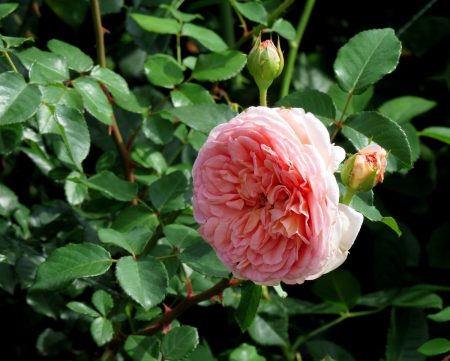

There are a large number of rose varieties with strong immunity against pathogenic microflora. Choosing them saves the gardener from a large layer of worries associated with prevention and treatment. Some of them:
- Remembrance;
- "Peace";
- "Westerland";
- Leonardo da Vinci;
- Golden Wedding;
- Amber Queen;
- Scarlet Queen Elizabeth;
- Glenfiddich;
- Arthur Bell;
- Chanelle;
- Pierre de Ronsard;
- "Beautiful Britain";
- Golden Celebration;
- "English Miss";
- "Black Magic";
- Fragrant Delight;
- William Shakespeare 2000;


- Anisley Dickson;
- Jubilee Celebration;
- Fellowship;
- Augusta Luise;
- Anne Harkness;
- "Wishing";
- City of London;
- Abraham Darby;
- "Double Delight";
- The Times Rose;
- "Nostalgie";
- Harvest Fayre;
- Dame Wendi;
- Flammentanz;
- Apricola;
- Queen Elizabeth;
- Cherry Girl;
- Jubile du Prince de Monaco;
- "Golden Years";


- Aspirin Rose;
- Margaret Merril;
- Crimson Meidiland;
- Valentine Heart;
- Escimo;
- Oranges and Lemons;
- Toprose;
- "Chippendale";
- "Korresia";
- "Chatsworth";
- "Princess Alexandra of Kent".
Care rules
- Once you have bought your favorite rose bush and brought it home, do not rush to replant it. Place the plant on the east or southeast window, let it get used to the new microclimate.
- Roses are watered as often as the soil dries up. Watering is carried out with settled (at least a day) ordinary tap water at room temperature.
- Roses respond well to leaf spraying. Spraying roses is carried out in the evenings with cold boiled water or a solution of special fertilizers in cold boiled water. The underside of the rose leaves is sprayed with a mist spray gun. But it is not worth spraying roses daily, even in summer.
- Once the moon is in the growing phase, there is a good time to reload the plant. Transplanting roses from a container to a pot must be carried out carefully - without destroying the clod of earth, without disturbing the roots. The roots of roses often have white or gray granules of complex fertilizer, they do not need to be removed or washed off. Before transplanting, a small amount of old soil is removed from the top of the earthen coma, gently loosening and removing it without damaging the roots.
- Roses need nutritious soil for good growth: a mixture of 4 parts turf, 4 parts humus soil and 1 part sand. When planting, it is necessary to add complex fertilizer granules to such soil. If you do not have the opportunity to prepare the necessary components for the potting mix, then roses can be planted in ready-made commercial soil.
- A new rose pot should be at least 2-4 cm in diameter and 5-7 cm in height larger than the container in which the plant was sold. Too large a pot is also not worth taking; the aerial part of the plant should be related to the volume of the pot as 1: 1. If the pot is ceramic and completely new (nothing has grown there yet), then it is pre-soaked in warm water for 2 hours before planting the roses (this is especially necessary if the pot is unglazed). If something has already been grown in the pot, it is well washed with a stiff brush in warm water, but without soap.
- A layer of drainage (preferably expanded clay) with a thickness of about 1 cm is placed on the bottom of a pot prepared for transplanting a rose.If the pot is without a drain hole (and it is impossible to make this hole), then the drainage layer should be at least 3 cm.Earth mixed with fertilizer granules, then sprinkled with a layer of earth without fertilizer.
Fertilization and stress
During flowering, the tree spends a lot of energy that needs to be replenished with top dressing. For this purpose, it is better to choose a complex fertilizer containing nitrogen, potassium and trace elements. Many growers note that hibiscus does not like mixtures with a high phosphorus content - flowers can even fall off from such feeding. However, you should not get carried away with nitrogen either, since instead of flowers you will get only green foliage.
Another reason hibiscus buds fall off is stress. This concept means any actions that lead to a change in the usual habitat of a plant: moving to another place, transporting it from a store, a draft, watering with cold water.Try to provide your pet with stable conditions, especially during flowering.
DETAILS: Planting and caring for lilacs. Growing Persian lilac
Tips and tricks from experienced florists and gardeners
- When starting to grow roses, you need to decide on the type and variety.
- Correctly chosen seedlings are of great importance for growing healthy and beautiful roses.
- You need to choose bushes with green, elastic stems, with a smooth, without spots, bark.
- High quality seedlings should have at least three shoots.
- They are sold with an open root system, and with a closed one in containers.
- Fragile roses, with a poorly developed root system, can freeze when planted in the fall.
- Pink seedlings in containers can be planted on cool days of summer.
- The best soil for roses is slightly acidic or neutral.
- Roses take root deeply, therefore, for planting seedlings, a hole must be prepared no smaller than 60 cm.
- Roses are planted when the soil has warmed up from mid-April to mid-May, and in mid-October.
- Before planting, the seedlings should be prepared. Long roots are pruned a little, dry ones are removed.
Important! The filamentous roots must not be touched.
Before planting, the seedlings are soaked in water for several hours. Fading inflorescences are cut off without waiting for their complete wilting. This stimulates them to form new peduncles. The land near the bush must be constantly loosened, weeds must be removed in a timely manner so that they do not take nutrients from the soil.
To grow beautiful roses, they need to pay attention and adhere to the recommendations for planting and caring. Blooming roses will decorate any garden and will bring joy. The most beautiful roses are those that are grown by their own hands.
Similar articles
Park rose planting and care in the open field
Polyanthus roses
Tea rose
Rose Santana
What it is?
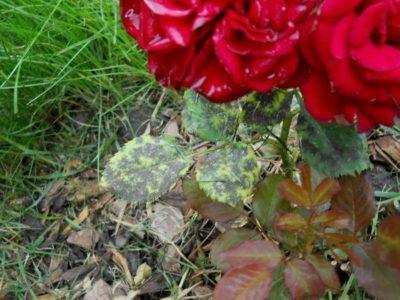

Yellowing is the appearance of a yellow tint on the leaves, stems or flowers of a rose, arising, as a rule, as a response to growing conditions unacceptable for a rose or pest infestation.
The intensity of the color change depends on the degree of damage and may be accompanied by drying or dying off of plant parts.
A symptom can manifest itself as the appearance of a yellow tint on the stem and flowers, active yellowing of the entire leaf plate or only the tips and edges of the leaf, the appearance of yellow spots. The process can start both from the top of the plant and from the lower leaves., depending on the reasons.
Care rules for the seasons
Summer
In summer, caring for a rose consists in watering, spraying, feeding, removing wilted flowers (with a pruner or a sharp knife, cut the peduncle to the first formed leaf bud). It is necessary to monitor the condition of the plant (so that the rose does not overheat; notice signs of diseases and pests that have appeared in time). If the rose grows very quickly, and the chosen pot is too small for it, wait until the moon growth phase and transfer the plant to a new, more spacious pot. If a rose stands on a window and is illuminated from one side, it, of course, reaches for the sun. In order not to get a one-sided bush, the rose pot must be turned from time to time to ensure uniform illumination of the bush.
Fall
In the fall, when the night temperature drops to 15-12 degrees, the rose is transferred from the balcony to the room and placed on the southern window sill. When a rose stops blooming and forming buds, it is prepared for wintering: less often it is watered (leaving the ground dry for a day or two before watering) and feeding is stopped. If possible, for the winter, the rose is placed on the windowsill of a cold room with a window (in winter, the air temperature in it should not be higher than 15-17 degrees). In an ordinary apartment with central heating, the following options are possible: a rose is placed between frames for the winter; or do not glue the window on which the rose hibernates in the fall; or fencing off the part of the window on which the rose hibernates from the rest of the room with plastic wrap.In any case, there should be no electrical and heating devices (computer, TV, heating battery, etc.) next to the wintering rose.
Winter
Before setting a rose for the winter, it is usually cut off, leaving 5 living buds on each branch; leaves are not removed. Pruning is done when the moon is in the growing phase. If you do not prune in the fall, then in the summer of next year the rose will bloom much later, the flowering will be less abundant, the bush will not look very neat. If you haven't pruned the rose before wintering, pruning can be done in the spring as well.
In winter, the rose will not grow and bloom, but will shed the remaining leaves and look very sad; at this time, caring for the plant consists in rare watering (after the soil dries up, water it after 2-3 days) and spraying. When wintering a rose in a room with central heating, it is recommended to put the plant pot on a pallet with wet pebbles or gravel and make sure that the stones are always moist - this will save the rose from excessive dryness of the air.
Spring
In spring, the rose has new leaves and twigs. At this time, they begin to water it more abundantly, the dried earth remains dry for no more than one day until the next watering. At the beginning of growth, the rose must be fed with a full mineral fertilizer, or a solution of mullein or bird droppings.
- Mullein solution: place 1/3 mullein and 2/3 water in a container, close and leave for 3-4 days, stirring occasionally. After fermentation stops, when the solution becomes lighter, it is ready (the fermentation time depends on the temperature, sometimes it takes 1.5 weeks). The ready-made mullein solution is diluted with settled tap water in a ratio of 1:15 (one part of the solution to 15 parts of water) - the feeding is ready.
- Poultry droppings solution: one part of poultry droppings is poured with 200 parts of hot water and insisted for two days. The finished solution is diluted with settled water in a ratio of 1:25 (1 part of the solution to 25 parts of water) and used for feeding.
The rose is fed after the usual watering. For the formation of large flowers, as soon as the buds are tied, the rose must be fed once a week. During the growth period, during the formation of buds, the rose should not experience a lack of moisture or light. The plant is exposed to the lightest window, watered as the soil dries up with settled water, in the evenings it is sometimes sprayed with cold boiled water from a thin spray bottle. As soon as the plant has outgrown the pot, it must be transferred, without disturbing the roots, into a larger pot. It does not matter in what season of the year the rose is transplanted; if necessary, you can transplant even in winter, but the moon should be in the growth phase.
When the spring frosts pass and a warm night temperature is established, it's time to take the rose out to the balcony or garden. In the first weeks, the rose must be gradually accustomed to the bright sun. To do this, the plant is first exposed in a shady corner of a balcony or garden and only after about two weeks is transferred to a sunny place. If there is no shady corner, use a "sliding shadow" from a sheet of thick paper with stripes cut in a checkerboard pattern of 8x2cm. Cover the rose with this leaf for 2-3 weeks.


Feeding problems
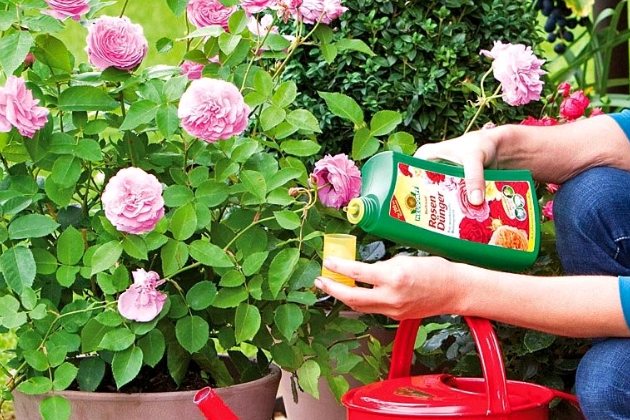

You can often observe yellowing of a room rose due to illiterate feeding. Both a lack of fertilizers and an excess of fertilizers can cause problems with leaves. Next, we will consider what mineral elements the flower requires and how they affect the state of the leaves.
Iron
In conditions of a lack of this trace element, the rose develops chlorosis. The state of chlorosis is precisely yellowing, wilting, twisting and further dying off of foliage. First of all, young foliage suffers from a lack of iron, but then chlorosis also affects adult leaves. The lack of iron also calls for a slowdown in growth, development, and the loss of decorativeness by the plant.
What to do
Iron deficiency needs to be replenished urgently.Most often, indoor roses growing in alkaline soil suffer from a lack of this trace element. To restore acidity, it is necessary to use special fertilizers with an acidifying effect.
If everything is normal with acidity, but iron deficiency is nevertheless identified, you need to use drugs such as Ferrilene, Ferrovit, etc.
Nitrogen
A rose usually experiences a lack of this trace element in the spring. Nitrogen deficiency is expressed in lethargy, pallor and yellowing of the foliage. A symptom of nitrogen deficiency is a change in color at the beginning of the lower leaves, gradually going up. After the color changes to yellow, the leaves begin to die off, then fall off.
What to do
To replenish the lack of nitrogen, you need to feed the indoor rose with a suitable mineral complex fertilizer or urea.
Manganese
If there is not enough manganese, the yellowing of the foliage will begin with the oldest leaves. Yellowness in this case occurs first between the veins, then goes from the edges to the center of the sheet. Interestingly, the entire leaf will not turn yellow: a green border will remain around the yellow island. Usually the problem arises from planting the rose in alkaline soil, or due to the introduction of too much lime into the soil.
What to do
The acidification of the soil, the introduction of manganese sulfate will help to correct the situation.
Magnesium
A lack of a trace element occurs when growing a rose in an overly acidic soil. At first, yellowing symptoms appear on old leaves, then on young ones. Pathology in this case manifests itself as spots on the leaves of a red-yellow hue. The edge of each affected leaflet remains green. If measures are not taken in time, all the greens can fall off.
What to do
The introduction of magnesium sulfate and wood ash will help restore the balance of magnesium in the soil. It is important not to overdo it with the amount of this microelement, since with its excess, potassium ceases to be absorbed.

